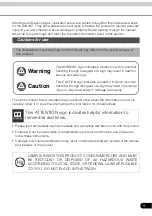
6
7
CQ-VD7003U
English
Battery Lead
If your stereo unit has a yellow lead, you will need to
locate the car's battery lead. Otherwise you may ignore
this procedure. (The yellow battery lead provides contin-
uous power to maintain a clock or other functions.)
If your car has a radio or is pre-wired for one:
With the ignition and headlights off, identify the car bat-
tery lead by grounding one lead of the test bulb to the
chassis and checking the remaining exposed wires from
the cut radio connector plug.
If your car is not wired for an audio unit:
Go to the fuse block and find the fuse port for the battery,
usually marked BAT.
Speakers (not supplied)
Identify the car speaker leads. There are two leads for
each speaker, usually color coded.
A handy way to identify the speaker leads and the speak-
er they are connected with is to test the leads using a 1.5
V AA battery as follows.
Hold one lead against one pole of the battery and stroke
the other lead across the other pole. You will hear a
scraping sound in a speaker if you are holding a speaker
lead.
If not, keep testing different lead combinations until you
have located all the speaker leads. When you label them,
include the speaker location for each.
❏
Connect All Leads
Now that you have identified all the wires in the car,
you're ready to begin connecting them to the LCD moni-
tor wires. Electrical Connections (
a
page 14-23) shows
the proper connections and color coding of the leads.
We strongly recommend that you test the unit before
making a final installation.
You can set the unit on the floor and make temporary
connections to test the unit. Use electrical tape to cover
all exposed wires.
Important:
Connect the red power lead last, after you
have made and insulated all other connections.
Ground
Connect the black ground lead of the power connector to
the metal car chassis.
Speakers
Connect the speaker wires. See the wiring diagram for
the proper hookups. Follow the diagram carefully to
avoid damaging the speakers and the stereo unit.
The speakers used must be able to handle more than 50
W of audio power. If using optional audio power, the
speakers should be able to handle the maximum amplifier
output power. Speakers with low input ratings can be
damaged.
Speaker impedance should measure 4 – 8
Ω
, which is
typically marked on most speakers. Lower or higher
impedance speakers will affect output and can cause
both speaker and stereo unit damage.
Battery
Connect the yellow battery lead to the correct radio wire
or to the battery fuse port on the fuse block.
Equipment
Connect any optional equipment according to the instruc-
tions furnished with the equipment. Read the operating
and installation instructions of any equipment you will
connect to this unit.
Power
Connect the red power lead to the correct car radio wire
or to the appropriate fuse port on the fuse block.
If the LCD monitor functions properly with all these con-
nections made, disconnect the wires and proceed to the
final installation.
❏
Final Installation
Lead Connections
Connect all wires, making sure that each connection is
insulated and secure. Bundle all loose wires and fasten
them with tape so they will not fall down later. Now insert
the LCD monitor into the mounting collar.
Congratulations! After making a few final checks, you’re
ready to enjoy your new LCD monitor.
Caution
¡
Never ground the speaker cords. For example, do
not use a chassis ground system or a three-wire
speaker common system. Each speaker must be
connected separately using parallel insulated
wires. If in doubt about how your car’s speakers
are wired, please consult with your nearest pro-
fessional installer.







































